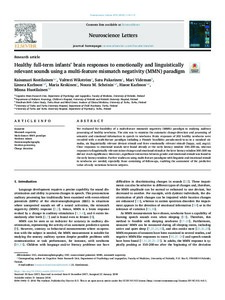Healthy full-term infants’ brain responses to emotionally and linguistically relevant sounds using a multi-feature mismatch negativity (MMN) paradigm
Kaisamari Kostilainen; Valtteri Wikström; Satu Pakarinen; Mari Videman; Linnea Karlsson; Maria Keskinen; Noora M. Scheinin; Hasse Karlsson; Minna Huotilainen
https://urn.fi/URN:NBN:fi-fe2021042719019
Tiivistelmä
We evaluated the feasibility of a multi-feature mismatch negativity (MMN) paradigm in studying auditory processing of healthy newborns. The aim was to examine the automatic change-detection and processing of semantic and emotional information in speech in newborns. Brain responses of 202 healthy newborns were recorded with a multi-feature paradigm including a Finnish bi-syllabic pseudo-word/ta-ta/as a standard stimulus, six linguistically relevant deviant stimuli and three emotionally relevant stimuli (happy, sad, angry). Clear responses to emotional sounds were found already at the early latency window 100–200 ms, whereas responses to linguistically relevant minor changes and emotional stimuli at the later latency window 300–500 ms did not reach significance. Moreover, significant interaction between gender and emotional stimuli was found in the early latency window. Further studies on using multi-feature paradigms with linguistic and emotional stimuli in newborns are needed, especially those containing of follow-ups, enabling the assessment of the predictive value of early variations between subjects.
Kokoelmat
- Rinnakkaistallenteet [27094]
